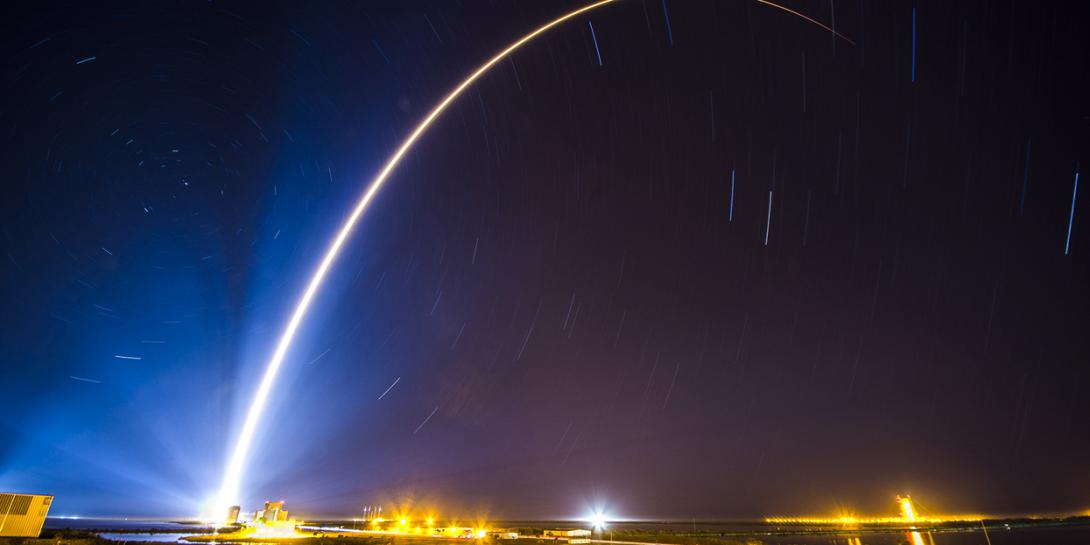U.S. Space Force To Be Joint Warfighting Service
To build the Space Force, the proposed sixth service of the U.S. military, the Defense Department will initially pull from all the services, not just the Air Force, according to Deputy Assistant Secretary of Defense for Space Policy Steve Kitay. It will truly be a joint warfighting service, he stressed.
“We believe that we have a strategic imperative to create a U.S. Space Force as the sixth branch of the Armed Forces,” Kitay stated. “The U.S. Space Force is going to be that unifying element for organizing, training and equipping [space-based capabilities]. And it is critical to establish a U.S. Space Force with a joint culture, that we do bring the elements of the services together as we create this identity and culture, and that it is not actually just Air Force people, because those other components have important roles in space as well.”
Kitay explained the importance of the U.S. Space Force at the AFCEA DC Chapter Monthly Luncheon on October 10. Held at the Army-Navy Country Club in Arlington, Virginia, the event, entitled The Evolution of DOD’s Space Components, also featured Paul "Rusty" Thomas, program manager of Defense Advanced Research Projects Agency’s (DARPA’s) Blackjack program; and Michael Schlacter, acting chief of the Space Development Agency's integration cell.
The Air Force’s Space Command, meanwhile, would be the joint warfighting element that brings the services together to actually conduct and plan for those operations, the deputy assistant secretary confirmed.
In addition, the Space Development Agency—known as the SDA, and which was stood up this spring—would eventually be moved into the Space Force “in the future at the appropriate time,” he noted. “It wouldn’t happen right away. We would get SDA up and running first.”
Stephen Kitay (2nd on r)
— Kimberly Underwood (@Kunderwood_SGNL) October 10, 2019
Deputy Assistant Secretary of Defense for Space Policy@DeptofDefense: we are at a strategic inflection point as far as our role in space and the threats we face @AFCEADC @AFCEADCEvents #SPACEFORCE pic.twitter.com/bNpXh8t21l
The intent of the Defense Department’s proposal in creating the Space Force is to unify the major aspects of its space program, outside of the current space-based responsibilities performed by the National Reconnaissance Office (NRO), which will stay at the NRO.
“We plan to pull those major components that are performing a global space function into the U.S. Space Force, to unify the activities in the DOD with one organization responsible,” Kitay said.
He recognized that those serving in the Army, Navy, Air Force, Marines and Coast Guard, which are performing space-related jobs now, may wonder if they will move to the Space Force. Kitay clarified that not everyone who has space expertise will be pulled into the new service. “We do need to continue to have people in those services who understand space,” he said and cited an example of the FA-40 space professionals in the Army.
“There will be elements of the FA-40s that will likely still remain in the Army, and similar constructs within the other services, because they are going to help integrate space into the services as well as articulate those requirements to each service,” the deputy assistant secretary said.
As proposed, the dividing line is that if it’s a global capability provided in a way where the central U.S. Space Force would be better suited to provide that function, DOD will align those functions. “There are elements in each service that will make sense to bring together in a coherent way into one service,” Kitay stated.
DOD is still waiting for approval on Capitol Hill for its proposal. The measure to create the U.S. Space Force is included in the fiscal year 2020 National Defense Authorization Act (NDAA 2020), which Congress failed to pass before the start of the FY.
“We are waiting on the legislation, and depending on how it is written, that will impact things,” he said.
Most Americans are not aware of the threats to the United States in space or how extremely important the Space Force is to our country, Kitay continued. However, the step to create the Space Forces comes from persistent and growing threats from adversaries, including China and Russia.
“The counter-space capabilities of our adversaries is what is driving the transformation in the Department of Defense,” the deputy assistant secretary noted.
Since 2007, China has demonstrated an antisatellite capability, a missile released from the surface of the Earth into space that destroyed one of their satellites, “leaving thousands of pieces of debris in orbit in space,” Kitay stated. In December of last year, the Russian Ministry of Defense claimed that the country has a ground-based laser that can destroy a satellite in orbit.
They have “kinetic effects, directed energy effects, and cyber effects,” he stressed. And in addition, “there are on-orbit activities that are very concerning to the United States.”
Moreover, it is not just the destructive capabilities that these countries have developed to destroy space assets, it is their doctrine, culture and organizations, which are all pointed toward space aggression or dominance.
“It is the scope and scale of threats to our space systems that we are facing,” the deputy assistant secretary warns. “The U.S. Defense Department has space systems in orbit that provide services to us every day, such as GPS. And capabilities that our soldiers, sailors, airmen and marines depend on from space to keep our country safe. We have to look at the vulnerabilities and how we are going to address them.”
Kitay implored that the United States cannot rest on its laurels in regard to space. “We need to continue to protect our freedom of operation in this key domain, because future wars will likely start or extend into space,” he stated. “And we have to be ready for that.





Comments